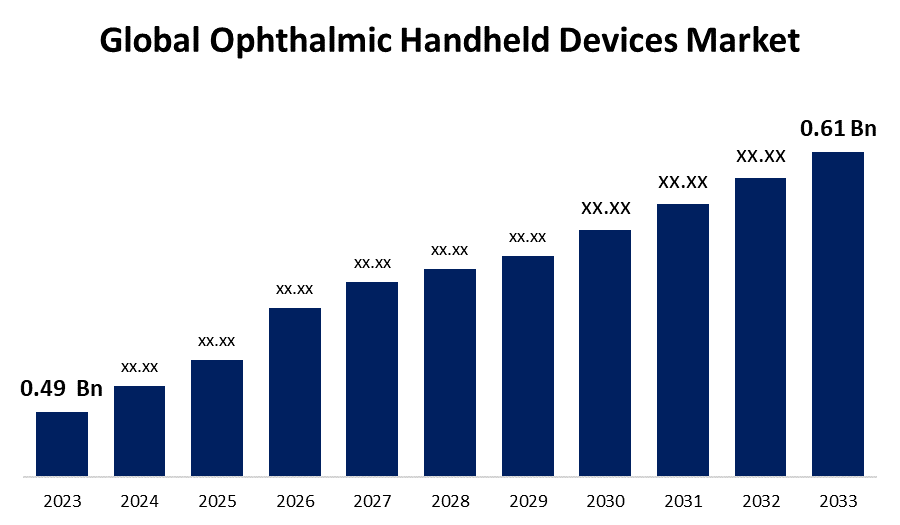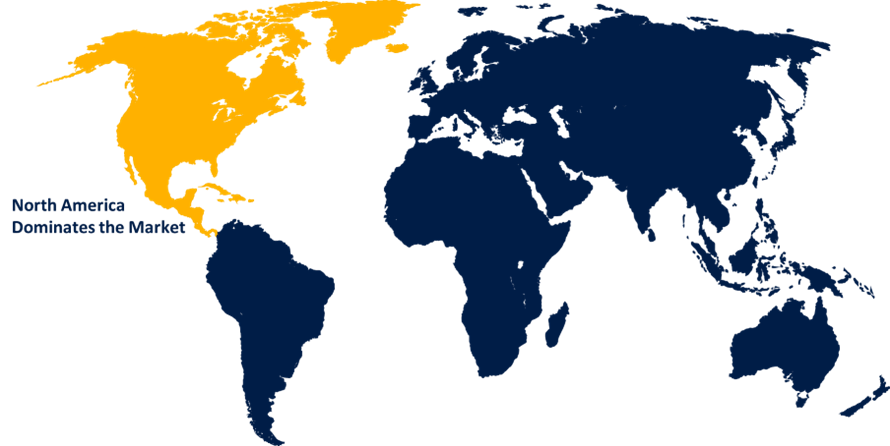Global Ophthalmic Handheld Devices Market Size, Share, and COVID-19 Impact Analysis, By Product Type (Ophthalmoscopes, Retinoscopes, Tonometers, Pachymeters, Autorefractors, Slit Lamp Biomicroscopes, Handhelds Fundus Cameras, and Other), By Category (Traditional and Digital/Smart Handheld Devices), By End-Use (Hospitals and Eye Clinics, Ambulatory Surgical Centers, and Others), and By Region (North America, Europe, Asia-Pacific, Latin America, Middle East, and Africa), Analysis and Forecast 2023 - 2033.
Industry: HealthcareGlobal Ophthalmic Handheld Devices Market Size Insights Forecasts to 2033
- The Global Ophthalmic Handheld Devices Market Size was Valued at USD 0.49 Billion in 2023
- The Market Size is Growing at a CAGR of 2.21% from 2023 to 2033
- The Worldwide Ophthalmic Handheld Devices Market Size is Expected to Reach USD 0.61 Billion by 2033
- Asia-Pacific is expected to Grow the fastest during the forecast period.

Get more details on this report -
The Global Ophthalmic Handheld Devices Market Size is Anticipated to Exceed USD 0.61 Billion by 2033, Growing at a CAGR of 2.21% from 2023 to 2033.
Market Overview
Ophthalmic handheld devices are portable and compact medical instruments designed for use in the field of ophthalmology. According to the International Agency for the Prevention of Blindness (IAPB), an estimated 130 million individuals worldwide were affected by refractive errors in 2012. Almost 95 million people aged 50 years and older are visually impaired from uncorrected refractive errors according to WHO. Eye care requires specific equipment to be correctly observed. Technological advancement for eye care includes the incorporation of several lenses, objectives, cameras, ultrasound, infrared sensors, lasers, etc. Further, the use of 3D imaging, virtual reality big data, and AI for data analysis in ophthalmology is revolutionizing the technology. Teleophthalmology is an integral clinical tool that could be particularly useful in primary care providing quality healthcare outside clinics. The Visionboost technology of HEINE Optotechnik’s Omega 600 Indirect Ophthalmoscope is useful when examining patients with dense media, such as cataracts or vitreous opacities due to enhanced illumination. Further, the cutting-edge diagnostic tool retinoscope plays a pivotal role in the precision and efficiency of refractive error diagnosis, integrated with electronic medical records. The optical and ultrasonic technique of pachymeter is used for measuring the thickness of the eye cornea. Slit lamps permit the use of 3D visualization and measurement of the anatomy of the eye. Companies like EyeNetra and Lunit leading the way in developing AI algorithms to enhance diagnostic efficiency and minimize human error. Portable devices possess the potential to revolutionize eye care, and also rising advancements in widefield imaging technology enable visualization of the retina in a single shot as compared to traditional ones.
Report Coverage
This research report categorizes the market for the global ophthalmic handheld devices market based on various segments and regions forecasts revenue growth and analyzes trends in each submarket. The report analyses the key growth drivers, opportunities, and challenges influencing the global ophthalmic handheld devices market. Recent market developments and competitive strategies such as expansion, product launch, and development, partnership, merger, and acquisition have been included to draw the competitive landscape in the market. The report strategically identifies and profiles the key market players and analyses their core competencies in each sub-segment of the global ophthalmic handheld devices market.
Global Ophthalmic Handheld Devices Market Report Coverage
| Report Coverage | Details |
|---|---|
| Base Year: | 2023 |
| Market Size in 2023 : | USD 0.49 Billion |
| Forecast Period: | 2023 – 2033 |
| Forecast Period CAGR 2023 – 2033 : | 2.21% |
| 023 – 2033 Value Projection: | USD 0.61 Billion |
| Historical Data for: | 2019 - 2022 |
| No. of Pages: | 200 |
| Tables, Charts & Figures: | 110 |
| Segments covered: | By Product, By Category, By End-Use, By Region |
| Companies covered:: | Haag-Streit Group, Topcon Corporation, Appasamy Associates, Katalyst Surgical, ASICO, LLC, INKA Surgical Instruments, Surgical Holdings, NIDEK CO. LTD., ZEISS International, HEINE Optotechnik GmbH & Co., And Other Key Vendors. |
| Pitfalls & Challenges: | Covid-19 Impact, Challenge, Future,Growth and Analysis |
Get more details on this report -
Driving Factors
The ongoing technological advancements and latest innovations in portable and versatile machinery such as devices to perform electroretinography tests and visually evoked potentials on patients are likely to drive the market growth. Teleoptometry and telemedicine are portable devices. There is a rising emphasis on AI in combination with ophthalmic technology which helps professionals to be more efficient in diagnosis and treatment. Thus, the need for effective and efficient diagnosis and treatment results is likely to enhance the market demand. There is a rising prevalence of eye disorders with an increasing geriatric population as these age groups are more prone to cause eye-related disorders. Thus regular eye examination and treatments surges the market demand. The rising investments in medical device companies are also responsible for driving the market. The growing awareness and adoption of a preventive healthcare model increases the market demand. The growing point-of-care testing, facilitating swift on-the-spot diagnosis, uplifts the global ophthalmic handheld devices market.
Restraining Factors
The high cost of devices in developing nations hampering the market growth. Further, the lack of skilled professionals (ophthalmic technicians) is also restraining the market.
Market Segmentation
The global ophthalmic handheld devices market share is classified into product type, category, and end-use.
- The ophthalmoscopes segment dominates the market with the largest market share through the forecast period.
Based on the product type, the global ophthalmic handheld devices market is categorized into ophthalmoscopes, retinoscopes, tonometers, pachymeters, autorefractors, slit lamp biomicroscopes, handhelds fundus cameras, and others. Among these, the ophthalmoscopes segment dominates the market with the largest market share through the forecast period. Detection and evaluation of symptoms of retinal detachment or eye diseases such as glaucoma especially in case of high BP, diabetes, or other diseases that affect blood vessels. There are direct and indirect ophthalmoscopes that are vital for the early detection and monitoring of eye-related disorders like diabetic retinopathy, age-related macular degeneration, and glaucoma. The advancement in ophthalmoscopes devices like digital ophthalmoscopes with built-in cameras, is particularly useful for monitoring changes over time. These factors are contributing to the market growth in the ophthalmoscopes segment.
- The digital/smart handheld devices segment is expected to grow at the fastest CAGR during the forecast period.
Based on the category, the global ophthalmic handheld devices market is categorized into traditional and digital/smart handheld devices. Among these, the digital/smart handheld devices segment is expected to grow at the fastest CAGR during the forecast period. The incorporation of digital sensors and high-resolution cameras into ophthalmic handheld devices is promoting market growth. Further, growing teleophthalmology and demand for remote patient monitoring driving the market in the digital/smart segment.
- The hospitals and eye clinics segment accounted for the largest market share in 2023.
Based on the end-use, the global ophthalmic handheld devices market is categorized into hospitals and eye clinics, ambulatory surgical centers, and others. Among these, the hospitals and eye clinics segment accounted for the largest market share in 2023. There is high patient flow in hospitals and clinics, thus requiring efficient and time-saving diagnostic tools allowing healthcare professionals to conduct quick eye examinations in busy clinical environments.
Regional Segment Analysis of the Global Ophthalmic Handheld Devices Market
- North America (U.S., Canada, Mexico)
- Europe (Germany, France, U.K., Italy, Spain, Rest of Europe)
- Asia-Pacific (China, Japan, India, Rest of APAC)
- South America (Brazil and the Rest of South America)
- The Middle East and Africa (UAE, South Africa, Rest of MEA)
North America is anticipated to hold the largest share of the global ophthalmic handheld devices market over the predicted timeframe.

Get more details on this report -
North America is projected to hold the largest share of the global ophthalmic handheld devices market over the forecast period. The elderly population in the United States (age 65 and older) is growing rapidly, estimated by the U.S. Census Department to reach 83.7 million by 2050. Thus growing geriatric population increases the prevalence of eye-related disorders in the region. Technological advancements and advanced ophthalmoscopes possess features like digital imaging, enhanced optics, and integration with HER systems. The highest healthcare expenditure and investment in advanced medical technologies contribute to market growth.
Asia-Pacific is expected to grow at the fastest CAGR growth of the global ophthalmic handheld devices market during the forecast period. Age, genetics, and lifestyle all have an impact on the prevalence of eye problems. Aging populations are associated with an increase in the prevalence of age-related eye disorders. These factors are expected to boost the ophthalmic handheld devices market in the Asia Pacific region during the forecast period.
Competitive Analysis:
The report offers the appropriate analysis of the key organizations/companies involved within the global ophthalmic handheld devices market along with a comparative evaluation primarily based on their product offering, business overviews, geographic presence, enterprise strategies, segment market share, and SWOT analysis. The report also provides an elaborative analysis focusing on the current news and developments of the companies, which includes product development, innovations, joint ventures, partnerships, mergers & acquisitions, strategic alliances, and others. This allows for the evaluation of the overall competition within the market.
List of Key Companies
- Haag-Streit Group
- Topcon Corporation
- Appasamy Associates
- Katalyst Surgical
- ASICO, LLC
- INKA Surgical Instruments
- Surgical Holdings
- NIDEK CO. LTD.
- ZEISS International
- HEINE Optotechnik GmbH & Co.
- Others
Key Target Audience
- Market Players
- Investors
- End-users
- Government Authorities
- Consulting And Research Firm
- Venture capitalists
- Value-Added Resellers (VARs)
Recent Developments
- In December 2023, Carl Zeiss Meditec AG announced an agreement to acquire the Dutch Ophthalmic Research Center (D.O.R.C.). The acquisition will extend the company’s leadership in the ophthalmic medical devices market and expand its position in the vitreoretinal surgery segment.
- In December 2023, Kubota Vision announced an agreement with AUROLAB for the development, manufacturing, supply, and distribution license of eyeMO.
Market Segment
This study forecasts revenue at global, regional, and country levels from 2020 to 2033. Spherical Insights has segmented the global ophthalmic handheld devices market based on the below-mentioned segments:
Global Ophthalmic Handheld Devices Market, By Product Type
- Ophthalmoscopes
- Retinoscopes
- Tonometers
- Pachymeters
- Autorefractors
- Slit Lamp Biomicroscopes
- Handhelds Fundus Cameras
- Others
Global Ophthalmic Handheld Devices Market, By Category
- Traditional Handheld Devices
- Digital/Smart Handheld Devices
Global Ophthalmic Handheld Devices Market, By End-Use
- Hospitals and Eye Clinics
- Ambulatory Surgical Centers
- Others
Global Ophthalmic Handheld Devices Market, Regional Analysis
- North America
- US
- Canada
- Mexico
- Europe
- Germany
- Uk
- France
- Italy
- Spain
- Russia
- Rest of Europe
- Asia Pacific
- China
- Japan
- India
- South Korea
- Australia
- Rest of Asia Pacific
- South America
- Brazil
- Argentina
- Rest of South America
- Middle East & Africa
- UAE
- Saudi Arabia
- Qatar
- South Africa
- Rest of the Middle East & Africa
Frequently Asked Questions (FAQ)
-
1. What is the CAGR of the global ophthalmic handheld devices market over the forecast period?The global ophthalmic handheld devices market is projected to expand at a CAGR of 2.21% during the forecast period.
-
2. What is the projected market size & growth rate of the global ophthalmic handheld devices market?The global ophthalmic handheld devices market was valued at USD 0.49 Billion in 2023 and is projected to reach USD 0.61 Billion by 2033, growing at a CAGR of 2.21% from 2023 to 2033.
-
3. Which region is expected to hold the highest share in the global ophthalmic handheld devices market?The North America region is expected to hold the highest share of the global ophthalmic handheld devices market.
Need help to buy this report?